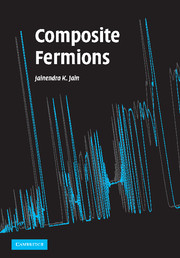Book contents
- Frontmatter
- Contents
- Preface
- List of symbols and abbreviations
- 1 Overview
- 2 Quantum Hall effect
- 3 Landau levels
- 4 Theory of the IQHE
- 5 Foundations of the composite fermion theory
- 6 Microscopic verifications
- 7 Theory of the FQHE
- 8 Incompressible ground states and their excitations
- 9 Topology and quantizations
- 10 Composite fermion Fermi sea
- 11 Composite fermions with spin
- 12 Non-composite fermion approaches
- 13 Bilayer FQHE
- 14 Edge physics
- 15 Composite fermion crystals
- Appendixes
- References
- Index
Preface
Published online by Cambridge University Press: 07 December 2009
- Frontmatter
- Contents
- Preface
- List of symbols and abbreviations
- 1 Overview
- 2 Quantum Hall effect
- 3 Landau levels
- 4 Theory of the IQHE
- 5 Foundations of the composite fermion theory
- 6 Microscopic verifications
- 7 Theory of the FQHE
- 8 Incompressible ground states and their excitations
- 9 Topology and quantizations
- 10 Composite fermion Fermi sea
- 11 Composite fermions with spin
- 12 Non-composite fermion approaches
- 13 Bilayer FQHE
- 14 Edge physics
- 15 Composite fermion crystals
- Appendixes
- References
- Index
Summary
Odd how the creative power at once brings the whole universe to order.
Virginia WoolfWhen electrons are confined to two dimensions, cooled to near absolute zero temperature, and subjected to a strong magnetic field, they form a quantum fluid that exhibits unexpected behavior, for example, the marvelous phenomenon known as the fractional quantum Hall effect. These properties result from the formation of a new class of particles, called “composite fermions,” which are bound states of electrons and quantized microscopic vortices. The composite fermion quantum fluid joins superconductivity and Bose–Einstein condensation in providing a new paradigm for collective behavior.
This book attempts to present the theory and the experimental manifestations of composite fermions in a simple, economical, and logically coherent manner. One of the gratifying aspects of the theory of composite fermions is that its conceptual foundations, while profoundly nontrivial, can be appreciated by anyone trained in elementary quantum mechanics. At the most fundamental level, the composite fermion theory deals directly with the solution of the Schrödinger equation, its physical interpretation, and its connection to the observed phenomenology. The basics of the composite fermion (CF) theory are introduced in Chapter 5. The subsequent chapters, with the exception of Chapter 12, are an application of the CF theory in explaining and predicting phenomena. Detailed derivations are given for many essential facts. Formulations of composite fermions using more sophisticated methods are also introduced, for example, the topological Chern–Simons field theory.
- Type
- Chapter
- Information
- Composite Fermions , pp. xiii - xivPublisher: Cambridge University PressPrint publication year: 2007

